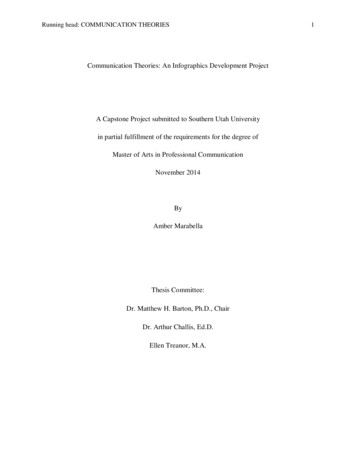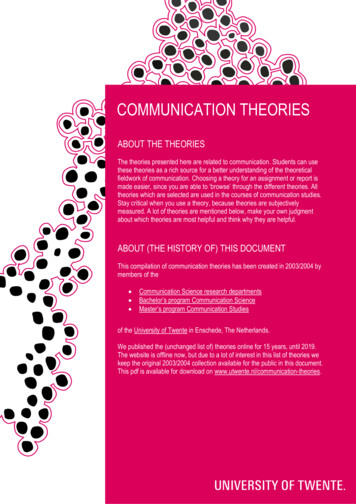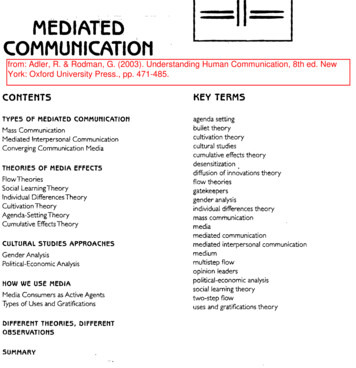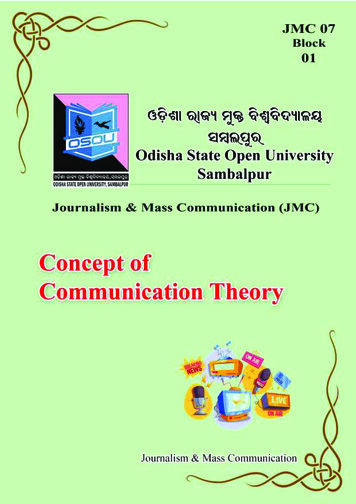
Transcription
Running head: COMMUNICATION THEORIES1Communication Theories: An Infographics Development ProjectA Capstone Project submitted to Southern Utah Universityin partial fulfillment of the requirements for the degree ofMaster of Arts in Professional CommunicationNovember 2014ByAmber MarabellaThesis Committee:Dr. Matthew H. Barton, Ph.D., ChairDr. Arthur Challis, Ed.D.Ellen Treanor, M.A.
COMMUNICATION THEORIES2Approval PageWe certify that we have read this project and that, in our opinion, it is satisfactory in scope andquality as a thesis for the degree of Master of Arts in Professional CommunicationCapstone Committee:Matthew H. Barton, Ph.D., ChairArt Challis, Ed.D., ChairEllen Treanor, M.A.
COMMUNICATION THEORIES3Table of ContentsTITLE . 1APPROVAL PAGE . 2ACKNOWLEDGMENTS . 4ABSTRACT . 5INTRODUCTION . 6LITERATURE REVIEW . 9A. Communication Theory . 9B. The Visual Learner . 10C. The Millennial Generation . 13D. Infographics & Success . 14E. Infographics Best Practices . 16PROJECT GOALS . 18METHOD . 19A. Infographics Layout . 23ANTICIPATED RESULTS . 24CONCLUSION . 25REFERENCES . 26APPENDICES . 32A. Figure 1.1: Infographic Layout . 32B. Figure 2.1: Sample Infographic . 33
COMMUNICATION THEORIES4AcknowledgementsFirst and foremost, I would like to thank Dr. Matt Barton for his continuous helpthroughout my 6 years at Southern Utah University. He was monumental in helping me decideto attend the Master’s program and I never would have made it through the two years without hisconstant help and guidance. It is with sincere gratitude that I thank him and all of the amazingprofessors in the Communication department for everything they have taught me. Thank youEllen Treanor for your ability to inspire creativity and for your advanced knowledge in all thingsmarketing related. Thank you Art Challis for your positive support and kind words. I have trulyloved my experience as a student in the Communication department and I can’t wait to see wherewhat opportunities open up for me.I would like to thank my wonderful, supportive mom, Jodie for all of the time she spenthelping me through this degree, including many, many phone calls, hours of editing time, andmuch more. She has been my constant guiding light throughout this process and I couldn’t havedone it without her. Thank you to my dad, Bob for his words of encouragement and belief in me,always sharing a positive thought when I needed it. Thank you to Alyssa for all of her randomhelp (printing, reviewing, etc.) and never ending ideas. Thank you also to Ross for cheering meon as I finished this degree. He will be next!Finally, I would like to thank my caring husband Erich who was my rock throughout thiswhole process. Even when he was thousands of miles away in Afghanistan, he encouraged me topush through it and finish my degree.I am truly blessed to have been surrounded by such an outstanding support teamthroughout my Master’s degree process. I couldn’t have done it without them. Here’s to the nextstage in life!
COMMUNICATION THEORIES5AbstractThis project addresses the need for visual aids in Communication theories classes. Twelveoriginal infographics were designed to help millennial-aged students better understand complex,intricate topics by explaining the theories in a primarily visual way. Due to the strong influenceof technology in today’s society, it is necessary to provide students with multi-faceted resourcesto learn new materials on both physical hard copy platforms, as well as electronic monitors. Thefinished infographics will be used in real, Communication theory classes to teach students thetheories in a new and visually interesting way.Keywords: Communication theories, infographics, visual learning, millennials
COMMUNICATION THEORIES6Communication Theories: An Infographics Development ProjectCommunication theories are a complex and complicated concept for college students.Theories include a plethora of information that must be quickly and efficiently presented duringthe timeframe of one or two semesters and often, these theories are explained using supplementaltextbooks to portray intricate ideas. During my first Communication Theories class, I rememberbeing overwhelmed by the number of theories and information covered in a short amount oftime. Some theories were easy to understand, while others were much harder for me to grasp andI struggled to truly understand them throughout the rest of my schooling. After discussingpossible project ideas with Dr. Matt Barton, he gave me the idea of portraying these complextheories in a new, visual context. Combined with my background in visual design, it seemed likea perfect match. Throughout this project I have had the opportunity to learn the theories ingreater detail and understand them at a new level. These completed infographics will be a greattool for future, incoming Communication students who will benefit from using them in class. Itwill also help bridge the gap between the education system of the past and the millennialstudents, who desire primarily visual tools to learn.According to a study published in The Chronicle of Higher Education (2005), theattention span of today’s students is changing. These “millennial” generation students (bornbetween 1980 and 1994) are unable to concentrate for long periods of time and struggle withconventional forms of learning. Based on the influx of new technologies into the lives of collegeaged students, recent studies have suggested that the regular use of technology-based itemsaffects the way students are able to learn and process information. Lee & Breitenburg (2010)describe this shift; “it means that visual learning, spatial and holistic thinking, the need to worksimultaneously in different media, and (most critically) the importance of active learning over
COMMUNICATION THEORIES7passive learning, are fundamental to the learning and cognitive processes of students today” (p.55). Many educators are struggling to find solutions to the shifting needs of students. Researchsuggests that by incorporating more visual aids, such as videos or graphic representations into alesson plan, millennial-aged students are better able to follow the material and grasp theconcepts, regardless of the subject matter. Hammer & Kellner (1999) found that, “properlyproduced and used, new multimedia technology enables students to better visualize, empathizewith, and understand historical events like the Holocaust, the incarceration of JapaneseAmericans during World War II, or even more ordinary instances of racism and prejudice” (p.522). Visual aids are especially helpful in the area of Communication. Although many of thetopics covered in these classes are often written and orally presented to students, it would behighly beneficial to offer them a visual tool to pair with this information. Graphic elementswould appeal to students on a variety of levels, based on their changing education preferences.This information shows the need for visual-based learning tools for the millennialgeneration and younger students working their way through the education system. It isimperative that instructors provide graphic representations of their subject matter to fully gaintheir students attention and to help them learn. This idea is especially important for complex orabstract areas of education, like theories, which are difficult to explain using only text-basedlearning. An experiment conducted by Garside & Edwards (1996) found that, “Undergraduatestudents often do not understand the process of theory formation or the relationship betweentheory and empirical research” (p. 6). These researchers suggested using an experiential learningformat, which allows students to have the ability to “experience, publish, process, generalize, andapply” the communication theories in the classroom (p. 1). Based on recent changes to thestudent population at large, it is suggested that this method should be combined with visual aids
COMMUNICATION THEORIES8to fully engage millennial-aged students. This will allow educators to further grasp studentattention and efficiently teach them Communication theories.To meet the needs of the transitioning learning styles of today’s students, it is importantto provide professors with tools that will help them teach effectively. The goal of this completedcapstone project will be to provide Communication Theory instructors with 12 full-color, visualrepresentations of common theories for undergraduate and graduate-level students. These visualaids will be available in both print and digital format to accommodate students learning in a faceto-face environment and in online classes. These visual aids, paired with scholarly, credibletextbook sources will help students understand the complex theories in the field ofCommunication. These students (often taking introductory Communication theory classes) willhave had little to moderate exposure to the theories and should be able to understand theCommunication language used in the graphics. The completed visual aid packet will beavailable for purchase for Communication instructors and students through a second partywebsite. Southern Utah University will be the first school offered the chance to test the visualaids in a classroom setting. This location fits the target audience due to the structure of a onesemester, Communication theory class, offered to students during their freshman, sophomore, orjunior year.For this project, the words “infographic” and “visual aid” will be used interchangeably todescribe the completed project. According to Ross (2009), information graphics or“infographics” are described as, “visual representations of information, data or knowledge”(n.p.). Because this project will include both graphic information, as well as copy text, thefinished product can be used as an infographic or can be used as a supplemental visual aid forCommunication courses.
COMMUNICATION THEORIES9Literature ReviewCommunication TheoryHuman beings have been communicating since the dawn of time. From cave drawings todrum sounds, the earliest humans discovered and developed ways to send messages to oneanother. Since then, a myriad of communication forms have been used including written, verbal,technological, and nonverbal communication. These types of communication have beenthoroughly studied and commonalities have been revealed, which have helped Communicationscholars to develop theories, or generalizations, about the way individuals communicate and thereasons they do so. According to Littlejohn & Foss (2011), scholastic interest in Communicationwas fueled by new forms of technology and increases in literacy during the early 20 th Century.This era was especially important in the United States, as “the nation was ‘on the move’ in termsof efforts to advance technology, improve society, fight tyranny, and foster the spread ofcapitalism” (p. 5). Scholars began to study the various forms of propaganda and advertising thatwas used during the First World War and continued to study these formats, during the nextWorld War as well. It was after this war that the study of Communication emerged as arecognized area of study. Scholars began to address concepts in communication that had beenstudied in other areas of social sciences including psychology, political science, and sociology.These concepts were labeled as “communication theories” and are now recognized ascornerstones in the field. Robert T. Craig (1999) proposed the idea that, “although there existmany theories of communication-indeed, way too many different theories to teach effectively inany one course-there is no consensus on communication theory as a field” (p. 120). Littlejohn &Foss (2005) continued this idea by stating that, “Theories are special forms of communication, so
COMMUNICATION THEORIES10theories constitute, or make, an experience of communication. Theories communicate aboutcommunication” (p. 8).Communication Theory is typically a foundation class for Communication majors at bothundergraduate and graduate levels. This class includes an overview of the most relevant theoriesin Communication, as well as insight into the reasons behind their importance in the field. Thesetheories are found in all areas of communication including interpersonal (such as Irwin Altmanand Dalmas Taylor’s “Social Penetration Theory”), mass media (such as George Gerbner’s“Cultivation Theory”), individual communication (such as Muzafer Sherif’s “Social JudgmentTheory”) and organizational communication (such as Irving Janis’s “Groupthink Theory”). Thetheories selected to teach in the class may be influenced by the age and level of the students, aswell as the instructor’s biases and subsequent worldview. Teaching theory can be difficult due tothe complex and abstract nature of theory in general, because it is often challenging to illustratethe ideas in a way that students will understand.The Visual LearnerIn 1992, Neil Fleming defined four main types of learning styles, known as the “VARK”style of learning. The acronym stood for Visual, Auditory, Read / Write, and Kinesthetic (n.p.).He suggested that every individual has a tendency to learn better using one of these fourfunctions, but each has the ability to use more than one style. When teaching in a classroomsetting, it is important to be aware of these learning styles and teach accordingly to accommodatethe needs of all students, regardless of their preferred learning style. Katsioloudis (2010) foundthat students from all varieties of learning styles respond well to detailed, high-quality visualaids, because this format interacts well with other styles. For instance, professors may pass out aphysical copy of a visual aid to assist kinesthetic learners, while orally explaining the material
COMMUNICATION THEORIES11for auditory learners. The aid may also include space for students to write their own informationfor read / write learners. Visual aids are a powerful tool for students from all learning styleswhen used properly. George (2013) indicated, “ that people remember visual representations‘more accurately, more quickly, and for a longer period of time’ than words alone” (p. 187). Aresearch study conducted by Trapit Marketing (2013) found that “82% of respondents said theybelieve that content is more likely to be consumed if it’s visual” (n.p.).David Hyerle (2008) cited research that found, “The brain is capable of absorbing 36,000images every minute,” and “between 80 and 90 percent of the information received by the braincomes through the eyes” (pg. 153). Research has shown that when used effectively and correctly,technology can play an important role in a student’s ability to process new information,especially when it is visual (Hammer & Kellner, 1999). Many of today’s students actually seekvisual learning tools, rather than the other forms of learning methods due to their interaction withvisual technologies (i.e.: television, computers, etc.) from a young age (Cooper, 2014). Some ofthese visual technologies found in classroom settings include the use of interactive whiteboards,projectors, tablets, laptops, and printed infographics.Visual aids must be created and used effectively or the device may distract students ratherthan assist in their learning. Doumount (2002) provided this explanation, “ effectiveillustrations are truly visual, not verbal. In other words, they do not rely on symbolic associationand can thus be interpreted correctly without a verbal step” (p. 221). If a visual aid is unclear orhard for students to understand, it may divert from the learning process.McKendrick & Bowden (1999) studied the effects that audio-visual tools had on distancestudents and found, “that integration of audio- visual resources into the mainstream curriculumand active learning on the part of students are essential to ensure effective and sustainable
COMMUNICATION THEORIES12deployment of audio-visual technology” (p. 9). Visual aids can also help aid in functionaldialogue in the classroom setting and encourage “discussions through questions, observations,and inferences about patterns and behaviors that they discover in the image data sets” (Smith &Blankenship, 2000, p. 764). These visual resources encourage students to view information andinteract with it, as well. When the type of visual aid is available in a physical format for students(such as a tablet or an infographic), it allows the student to use more than one type of learning,thus increasing the chance of the information staying with the student. In a study conducted oninteractive white boards in a classroom, Beeland (2002) concluded, “ that interactivewhiteboards can be used in the classroom to increase student engagement during the learningprocess (p. 6)” as it can help “to attract and maintain student attention and to improve studentachievement” (p. 7).Along with the technological forms of visual education aids, there is a growing interest in“infographics,” or graphics that display information. According to Toth (2013):They attempt to educate an audience about a specific topic or issue in a visuallyinteresting and easily navigable manner through a combination of words and visuals.Infographics often communicate complex quantitative and/or qualitative informationquickly for their audience. They typically combine data displays, lists, graphics, and othervisual elements to make a point; they intend to inform, and frequently persuade, theirintended audience about a focused topic (p. 448).Infographics have been used in a variety of areas to convey complex information to theiraudience. Davidson (2014) explained, “Infographics incorporate art into the normally staid worldof numerical information” (p. 35). These visual aids are a unique way to teach viewers in a quickand straightforward manner that resonates well with modern audiences. Infographics are easily
COMMUNICATION THEORIES13shared when produced in digital formats and can be dispersed through social media or emailmarketing platforms. Researcher Mastrianni (2014) found that almost 25% of emails are openedfor less than 3 seconds and only have a 50% open-rate when the subject line is short (n.p). Incontrast, one study found that transactional emails, including infographics have an average openrate of over 100%, because people open them multiple times and share them with others(Johnson, 2014). This type of response should be kept in mind when creating and developingmaterials for a changing audience, including the millennial generation that boasts a primarilyvisual learning style.The Millennial GenerationThe millennial generation is especially drawn to infographics and other forms of visualtechnology information due to their almost constant interaction with technology. Iozzio (2013)found that, “Devices can be friends or teachers, not just tools or entertainment” (p. 28). Studentsare drawn to technology, because they interact with these devices throughout the day. From themoment they wake up with their cell phone alarm clock to their final tweet of the day, they usethese resources to connect, learn, and function. Millennials are used to technology and expect iteverywhere, including the classroom. This age group can be especially hard to teach due to theirunique personality characteristics. Howe & Nadler (2009) explained, “Millennials have broughtwith them a very different set of attitudes and behaviors than the youth who preceded them: aconfidence and conventionality, a preference for group consensus, an aversion to personal risk,and a self-image as special and as worthy of protection” (p. 3). Millennials are also considered“digital natives” or individuals who have grown up with technology (Edwards, et. al, p. 4). Thesetraits can have a great impact on the way these students interact in a classroom setting, as Benfer& Shanahan (2013) discussed, “Oral communication can be extremely challenging for millennial
COMMUNICATION THEORIES14students, who are accustomed to communicating briefly and spontaneously via instantmessenger, e-mail or text message” (p. 33).Based on this information, it is important to understand how to incorporate visual andinteractive illustrations into a classroom setting to meet the needs of millennial generationstudents. Roehling, et al. (2011) conducted multiple focus groups with these students andaddressed many of the methods students were looking for in the classroom. “Millennial studentshave been raised in an entertainment focused, multimedia environment in which they rapidlyshift their attention from one source of information or stimulation to another. As a result, thesestudents tend to have a low tolerance for boredom and require high levels of stimulation toremain focused” (p. 2). Millennial-aged students have different customs and educationrequirements than those of past generations and it is important to understand how these idealsaffect them in classroom settings.Infographics & SuccessWith the influx of new technologies, there is an increasing emphasis on creating anddesigning information to be viewed on digital screens (such as cell phones, computers, tablets,televisions, etc.). According to Buck (2012), “The world’s biggest social media properties havequickly made visual content a huge priority, often designing or re-designing their entireplatforms to nurture such media” (n.p.). These technologies allow users to access informationanytime, anywhere, with the click of a button. This accessibility makes the job of designers andmarketers difficult, because they must create products that appeal to the correct audience, whilealso holding their attention. Certain digital platforms have been historically more successful thanothers.
COMMUNICATION THEORIES15Infographics are one tool that has been highly effective at spreading information throughInternet platforms, because it contains a large amount of information in a concise way. Toth(2013) explains, “ [an] important element of infographics is that they function as stand-alonecommunication: An audience should comprehend the information from simply lookingat it without seeking additional sources to understand it” (p. 448). This simplicity allows thevisual aid to be rapidly understood and forwarded to other audiences. One way of spreading thisinformation is through the use of emails. ExactTarget (2014) states that, “Nine out of every 10consumers say they check their email every day” (n.p.) and the shorter the subject line, the morelikely, the email will be opened. This can be important for marketers looking to reach a broadaudience quickly. By including “infographics” in emails, there is a higher chance the viewer willwant to open it.Another means of distributing infographics is through social media. With the influx of“sharing” social media sites, like Pinterest and Facebook, users can post and share infographicswith their friends. By sharing infographics through social media platforms, up to 15 millionviewers could potentially interact with the visual aid (Li, 2013). It is most likely that the majorityof this number will be millennials. Taylor (2014) explains, “The average millennial spends 18hours a day consuming media – often multiple forms at once the average millennial checks hisor her smartphone 43 times and spends 5.4 hours on social media per day” (n.p.) Infographics arean important addition to the online world and are a needed tool for millennial-aged students.Infographics have been used in a variety of sectors including advertising, marketing,business, social media, and education. Combined with the changing needs of today’s students,these aids help students to understand information in a way that communicates with them. Davis& Quinn (2013) found, “Infographics can support reading comprehension and writing while
COMMUNICATION THEORIES16strengthening critical thinking and synthesizing skills” (p. 16). By presenting information in avisual format, students can use the image to help them understand the corresponding text. Unlikestandard text-heavy resources, infographics display information in layouts that often includewhite space, larger gaps between sentence lines, and boxes or graphs to separate information.Infographics Best PracticesInfographics should provide viewers with a quick, easy to understand message about aparticular topic. It is important to show information that is captivating, engaging, and visuallyclean to guide an audience to where they need to go. Kenner (2014) explains, “Determine the onething you want to communicate, and what you want your audience to do with (or feel about) it”(n.p.). Infographics should only contain key details and should avoid clutter to share theirmessage. According to Ross (2009), “the basic and key material of an information graphic is thedata, information, or knowledge that the graphic presents with limited resources” (n.p.). Theseelements are typically created by the designer to match the flow of the article or the overalltheme of the entity where the graphic will be presented. Infographics often contain three mainparts, as explained by David (2012), “The Visual ( colors, graphics, and icons ), The Content( text, statistics, time frames, and references) and The Knowledge ( the facts and conclusionsto convey the overall message of a story) (n.p.). An infographic may also include a key, scale,and label to better explain the representations of the document.It is important to note that as the name implies, infographics should represent theinformation as visually as possible without including a lot of text. In theory, an infographicshould still make sense to the viewer without the inclusion of words or copy. In their “EmailDesign Checklist,” emailmonks.com (2013) provides multiple relevant tips for the creation ofbody copy for infographics:
COMMUNICATION THEORIES17A. Use short sentences and paragraphsB. Use design elements like spacing and dividing lines to distinguish the content sectionsfrom one anotherC. Use bold typeface and sub-headers to make certain words stand outD. Use bullet points to showcase benefits (p. 1).The infographic should be organized in a way that makes sense to the viewer, whileaccurately portraying the information. It should lead the viewer’s eye in the proper order to helpthem understand the data. Many designers will create a “wireframe” version of the layout todetermine where the pertinent information will go. For the communication theories infographicproject, the layout will be relatively similar for each theory, so that the reader will quickly findthe necessary information. Each design should have a “hook,” or a visual focal point that willdraw the reader to the object. Balliette (2011) explained, “Give the most important informationthe most visual weight, so that viewers know what to take away” (n.p.). To show the informationin an organized manner, a “grid” design will be used for the 8.5” x 11” page. Graphic designerJennifer Kyrnin (2010) explained, “If you use a grid to design your web page layout, you’llcreate designs that look right and feel comfortable to most people The point of a grid is not as away to fill up space, but to help you organize the space you have” (n.p.). This grid will be shownby including 3 point lines between main segments and creating visual guides that help the readerto see where they should go next. Because the infographics will be viewed on both digitalformats (tablets, computers, web pages, etc.) and hard copy formats (printed, inclusion intextbook), this grid will also aid in creating unity for the viewers, no matter which platform theyare using.
COMMUNICATION THEORIES18It will be necessary to develop designs that easily translate to either platform by keepingrelevant design elements in mind, including color, page layout/size, and interaction. For thisreason, the colors will be limited to three or four per design. According to Balliette (2011), “Athree-color palette is easy on the eyes.” She also explains that this three-color palette includes thebackground, which should be the lightest of the three (n.p.). The backgrou
Communication theories are a complex and complicated concept for college students. Theories include a plethora of information that must be quickly and efficiently presented during the timeframe of one or two semesters and often, these theories are explained using supplemental textbooks to portray intricate










